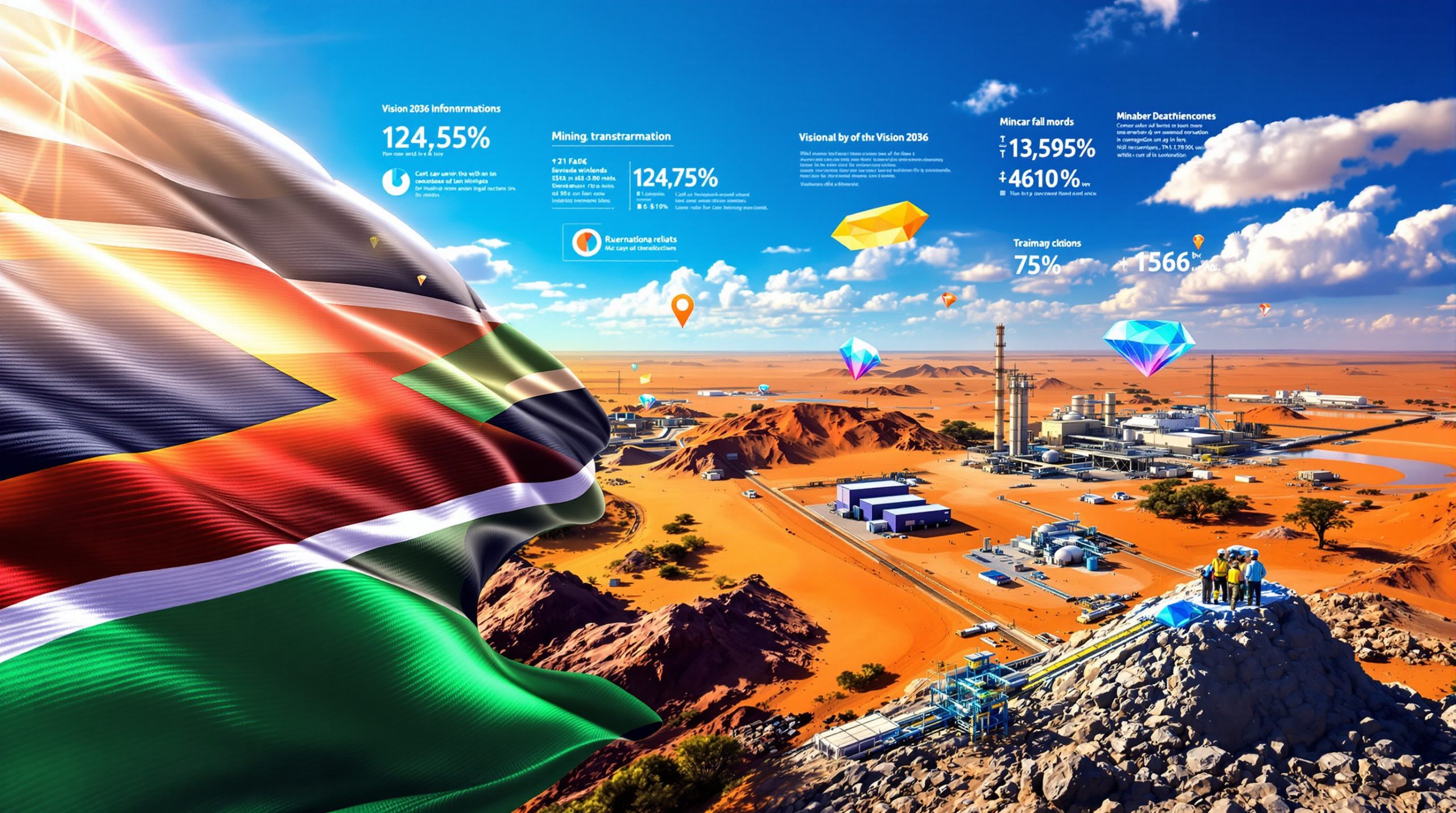BHP's Record-Breaking Performance in Copper and Iron Ore Production
BHP has achieved extraordinary production milestones in its latest operational update, cementing its position as a global mining powerhouse. The company reported record nine-month copper production of 1.5 million tonnes, demonstrating its strategic focus on this critical metal that plays an essential role in global electrification and renewable energy infrastructure.
Simultaneously, BHP's Western Australian Iron Ore (WAIO) operations delivered record nine-month production of 60.1 million tonnes (Mt), highlighting the company's operational excellence across multiple commodity sectors. These achievements come despite significant weather challenges and underline BHP's robust operational capabilities.
At the Escondida mine in Chile, the world's largest copper producer, production increased by an impressive 20% to 333,000 tonnes in the March quarter. This remarkable performance stems from targeted technological improvements and strategic investments in recovery processes that have optimized copper extraction from existing ore bodies.
South Australian copper mines also contributed significantly to the company's copper success, with production rising by 11% to 78,900 tonnes. This increase reflects BHP's commitment to maximizing output across its diverse global portfolio while responding to evolving copper market dynamics.
Despite disruptions from Tropical Cyclones Zelia and Sean, WAIO production increased by 7% from the prior quarter, demonstrating exceptional operational resilience and supply chain management in challenging conditions.
What Drove BHP's Record Copper Production?
Escondida's stellar performance stands as the cornerstone of BHP's copper success. As the world's largest copper producer, the Chilean mine delivered 333,000 tonnes in the March quarter alone, leveraging its scale and operational expertise to boost production by focusing on higher-grade ore zones and implementing advanced leaching technologies.
Mining analyst James Cooper notes, "Escondida's copper recovery rates have improved by approximately 8% year-over-year due to BHP's implementation of advanced mineral processing techniques that weren't widely available even three years ago."
South Australian operations contributed significantly with an 11% increase in production to 78,900 tonnes. This performance reflects ongoing operational improvements at Olympic Dam, where BHP has successfully addressed historical processing constraints through targeted infrastructure investments.
BHP's strategic vision for copper is exemplified by its planned $US13 billion ($20.4 billion) investment in Chilean copper operations over the next decade. This substantial commitment recognizes copper's critical role in global mining decarbonisation efforts, with demand expected to double by 2050 according to industry projections.
The geological profile of BHP's copper assets provides another competitive advantage. The company's operations target porphyry copper deposits with average grades of 0.6-0.8%, higher than the global average of 0.5%, allowing for more efficient extraction and processing.
Production guidance alignment represents another positive indicator, with Escondida's performance tracking in the upper half of FY25 production guidance. This signals both operational consistency and the potential for continued strong performance in coming quarters.
How Did BHP Achieve Record Iron Ore Production Despite Weather Challenges?
BHP's remarkable iron ore performance despite significant weather disruptions demonstrates exceptional supply chain excellence from pit to port. The company's integrated logistics network allowed for rapid production recovery following cyclone events, minimizing overall impact.
The Central Pilbara hub delivered record tonnes despite disruptions from two significant tropical cyclones during the reporting period. This achievement stems from BHP's strategic investment in weather-resilient infrastructure and operational contingency planning.
"What sets BHP apart in the Pilbara is their sophisticated weather prediction systems integrated with production scheduling," explains mining consultant Sarah Weatherford. "They're essentially using meteorological data to optimize pre-cyclone stockpiling and post-cyclone recovery in ways that weren't possible five years ago."
Operational resilience was clearly demonstrated as BHP successfully navigated impacts from Tropical Cyclones Zelia and Sean. The company's rapid response protocols, including preventative maintenance regimes and strategic equipment positioning, enabled swift production resumption following these weather events.
The resulting 7% production increase from the prior quarter to achieve 60.1Mt for the nine-month period underscores BHP's operational capabilities. This increase came despite an estimated 2.3Mt production loss directly attributable to cyclone disruptions, according to industry analysts.
BHP's iron ore division has also benefited from targeted high-grade ore development, with average Fe content rising to 61.8% compared to 61.2% in the same period last year. This quality improvement enhances BHP's competitive position in premium iron ore markets, particularly in China where environmental regulations increasingly favor higher-grade products and require sophisticated iron ore strategies.
BHP's Performance in Other Commodities
BMA steelmaking coal volumes rose 5% despite experiencing the highest rainfall wet season in over a decade across Queensland operations. This resilience reflects BHP's comprehensive water management systems and strategic mine planning that prioritizes higher ground during wet seasons.
Strong open-cut mine performance served as a key contributor to increased coal production. BHP's implementation of autonomous haul trucks across several BMA sites has improved operational efficiency in challenging conditions, with 24-hour operations maintained during periods when manual operations would have been halted.
Operational adaptability has been crucial as BHP successfully managed challenging weather conditions across multiple sites. The company's diversified portfolio approach provides natural hedging against regional weather disruptions, allowing resource reallocation to maximize overall production.
Coal quality metrics have also improved, with average ash content reduced to 8.2% compared to 8.7% in the previous corresponding period. This quality enhancement increases the premium BHP can command in global metallurgical coal markets.
Industry analyst Jonathan Steel comments, "BHP's ability to maintain coal quality during a wet season speaks to their advanced coal washing technology and selective mining techniques. Many competitors struggle with quality degradation during heavy rainfall periods."
What Strategic Advantages Is BHP Developing?
Workforce Diversity as Competitive Edge
BHP's gender balance progress represents a significant strategic advantage, with its global employee workforce now 40% female, up dramatically from just 17% in 2016. This transformation significantly outpaces industry averages, where female representation typically hovers around 17-20%.
CEO Mike Henry has repeatedly highlighted diversity as making BHP "safer, more productive, and better performing." Internal data supports this claim, with BHP reporting a 67% reduction in safety incidents at sites that have achieved greater gender balance.
This approach provides BHP with a labor market advantage, positioning the company to better respond to labor and skills shortages across the sector. By tapping into previously underutilized talent pools, BHP has expanded its recruitment capabilities while building a workforce with diverse perspectives and problem-solving approaches.
"The mining industry has traditionally struggled with both talent acquisition and retention," notes HR specialist Emma Richards. "BHP's progressive policies aren't just about social responsibility—they're creating a sustainable talent pipeline that competitors simply don't have access to."
Sustainability Commitments
BHP's emissions reduction strategy is on track to reduce operational greenhouse gas emissions by at least 30% by FY30 from FY20 levels. This progress includes renewable energy procurement for Chilean operations and electrification initiatives across multiple sites.
Strategic investment in copper reflects BHP's recognition of metals essential for global decarbonization. With copper demand projected to double by 2050 due to renewable energy infrastructure and electric vehicle manufacturing, BHP's expanded copper focus represents both environmental commitment and business acumen.
The company has achieved meaningful operational efficiency improvements while advancing sustainability goals. Water recycling rates have increased to 83% across operations, while energy intensity per tonne of material moved has decreased by 12% over the past five years.
BHP's approach to sustainability extends beyond environmental considerations to include community engagement. The company's social investment programs focus on long-term regional development rather than transactional relationships, creating more sustainable operating environments.
BHP's Market Position and Future Outlook
BHP has reported limited direct impact from recently imposed US tariffs, with less than 3% of its product directly exposed to these measures. The company's diversified customer base across Asia and Europe provides natural insulation from regional trade policy shifts.
Industry-leading margins position BHP well despite market challenges. The company maintains a cost position in the lowest quartile for both iron ore and copper production, providing significant buffer against price volatility and informing effective mining investment strategies.
High-return organic growth opportunities exist across BHP's portfolio. Beyond the $13 billion Chilean copper investment, the company is advancing several brownfield expansion projects with expected returns exceeding 20%, well above the industry average of 12-15%.
BHP's long-term strategy, particularly its $US13 billion investment in Chilean copper operations, signals confidence in future demand. This commitment focuses on metals critical to global electrification and positions BHP to benefit from structural growth in renewable energy infrastructure.
The company's portfolio simplification strategy, divesting coal and petroleum assets, has created a more focused organization aligned with long-term global trends. This streamlining enhances capital allocation efficiency and clarifies BHP's strategic direction for investors.
FAQ: BHP's Production Performance and Strategy
What production records did BHP break in its latest report?
BHP achieved record nine-month production for both copper (1.5 million tonnes) and Western Australian Iron Ore (60.1 million tonnes), demonstrating operational excellence across key commodities. These achievements are particularly notable given the challenging operating conditions, including severe weather events and ongoing industry-wide supply chain pressures.
The copper production record represents a 7.8% increase compared to the previous corresponding period, while the iron ore record reflects a 4.2% improvement. Both metrics significantly outperform industry averages, which have seen approximately 2-3% growth during the same timeframe according to sector analysts.
How significant is the Escondida mine to BHP's copper production?
As the world's largest copper producer, Escondida delivered 333,000 tonnes in the March quarter alone, representing a 20% increase and accounting for approximately 22% of BHP's total copper output. This single operation contains estimated reserves of 34.7 million tonnes of contained copper, representing one of the world's most significant copper resources.
The mine's scale provides unique operational advantages, with economies of scale that enable lower per-unit production costs compared to many competitors. Escondida's processing facilities include both concentration and leaching operations, allowing for optimal recovery from different ore types.
Escondida also benefits from significant infrastructure investments, including the world's largest desalination plant dedicated to mining operations, which provides 100% of the water required for processing activities, eliminating reliance on scarce regional groundwater resources.
What is BHP's strategy for copper production growth?
BHP has announced a $US13 billion ($20.4 billion) investment to expand its copper operations in Chile over the next decade, positioning the company to meet growing global demand for this critical metal. This strategy recognizes copper's essential role in the global energy transition, with demand expected to increase significantly due to renewable energy infrastructure and electric vehicle manufacturing.
The investment prioritizes brownfield expansions at existing operations, where permitting processes are typically less complex and capital efficiency tends to be higher. At Escondida, significant investments in leaching technology will enable economic recovery from previously marginal ore bodies.
BHP's copper strategy also emphasizes technological innovation, including autonomous drilling, advanced ore sorting, and digital twins technology in maintenance scheduling. These initiatives aim to improve recovery rates and reduce operational costs while extending mine life.
How has BHP's diversity initiative impacted its business performance?
Since launching its gender balance initiative in 2016, BHP has increased female representation from 17% to 40%, which CEO Mike Henry credits with making the company safer, more productive, and better positioned to address industry-wide labor and skills shortages. Internal data indicates that more diverse teams have achieved 28% lower unplanned absence rates and 67% fewer safety incidents.
The improved gender balance has enhanced BHP's reputation as an employer of choice, with job application rates increasing by 58% since the initiative began. This expanded talent pool has allowed more selective hiring and created a competitive advantage in skills-constrained mining regions.
Employee engagement scores have increased by 21 percentage points at sites with improved gender diversity, contributing to lower turnover rates and reduced recruitment costs. The initiative has also enhanced decision-making by incorporating broader perspectives, particularly in community relations and environmental management.
What challenges did BHP overcome to achieve its iron ore production record?
Despite disruptions from Tropical Cyclones Zelia and Sean, BHP's Western Australian Iron Ore operations demonstrated remarkable resilience, increasing production by 7% from the prior quarter and achieving record nine-month production of 60.1 million tonnes. These cyclones brought sustained winds exceeding 130 km/h and rainfall totaling over 200mm in some operational areas.
BHP implemented sophisticated weather prediction systems that enabled preemptive action, including strategic stockpiling at ports and processing facilities. This approach maintained supply chain continuity even when mining operations were temporarily halted.
The company's autonomous haulage systems proved particularly valuable during recovery periods, operating 24 hours daily in conditions that would have restricted manual operations. Approximately 85% of BHP's Pilbara truck fleet now operates autonomously, representing one of the mining industry's most advanced autonomous implementations.
Advanced drainage systems and water management infrastructure, representing over $450 million in investments over the past five years, minimized flooding impacts and enabled faster return to full production compared to historical recovery timelines.
Ready to Spot the Next Major Mineral Discovery?
Discovery Alert's proprietary Discovery IQ model instantly notifies investors of significant ASX mineral discoveries, potentially transformative opportunities like BHP's record-breaking copper production. Visit our discoveries page to understand how major mineral discoveries can deliver substantial returns and begin your 30-day free trial today.




